
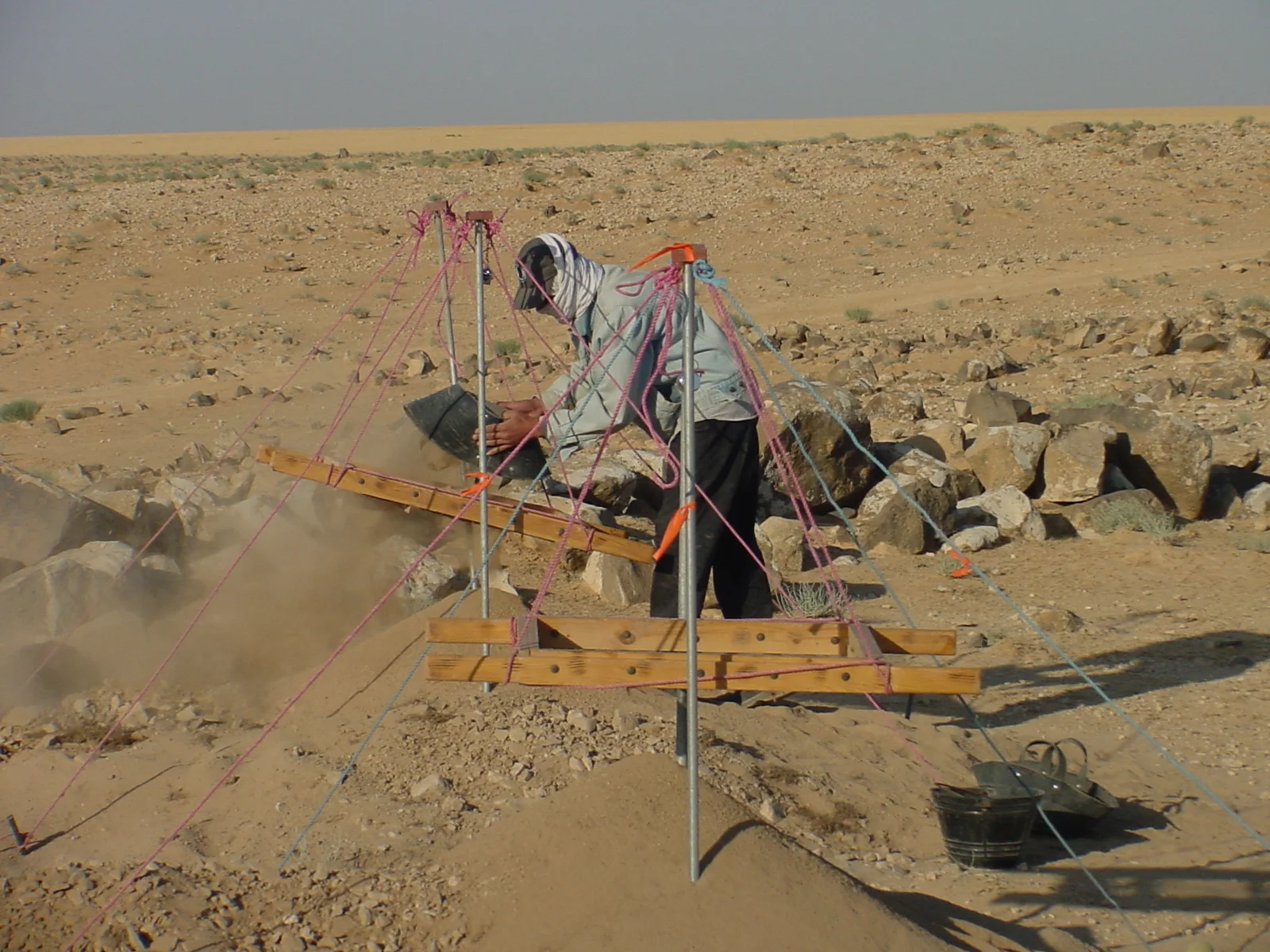

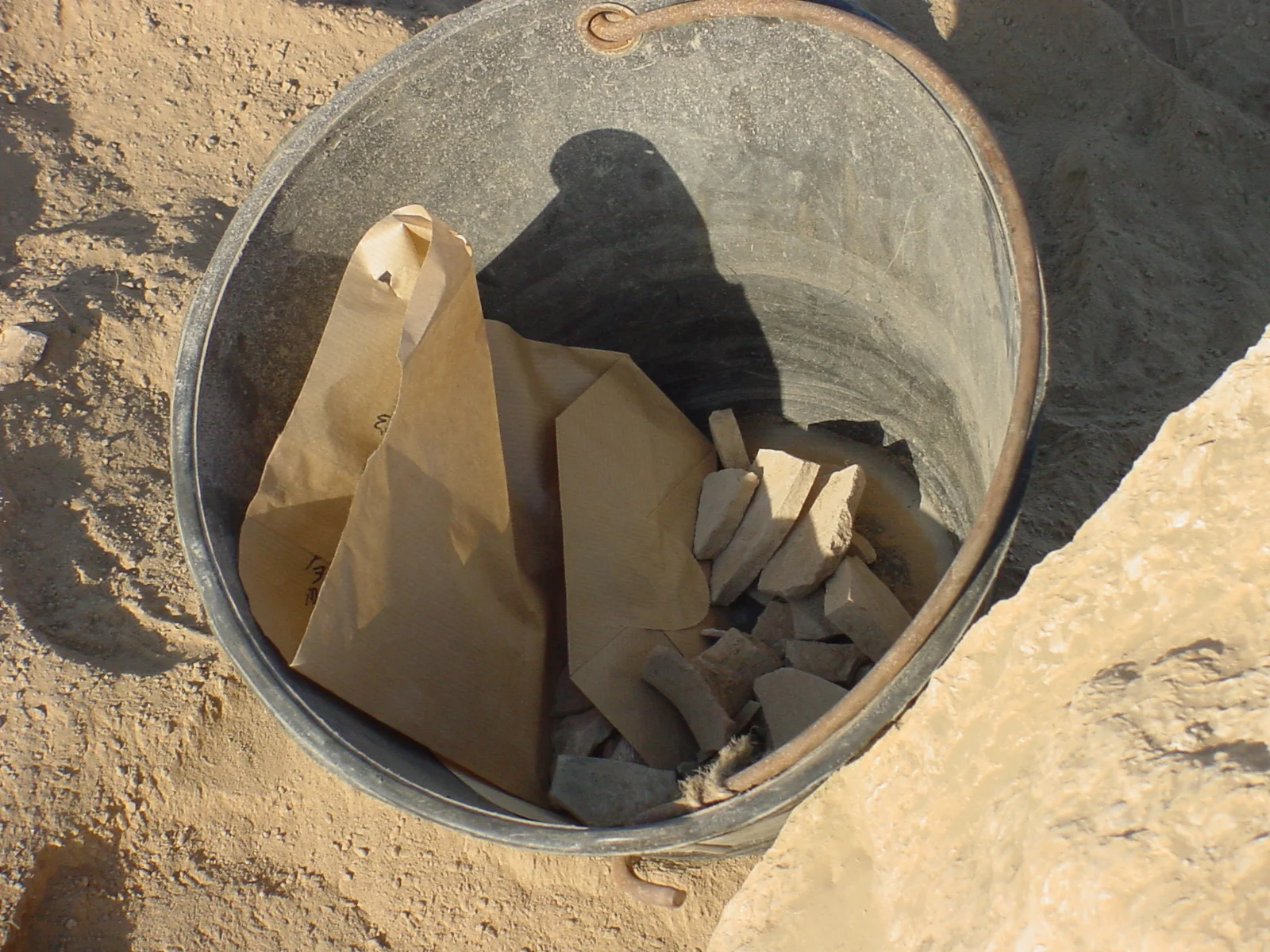
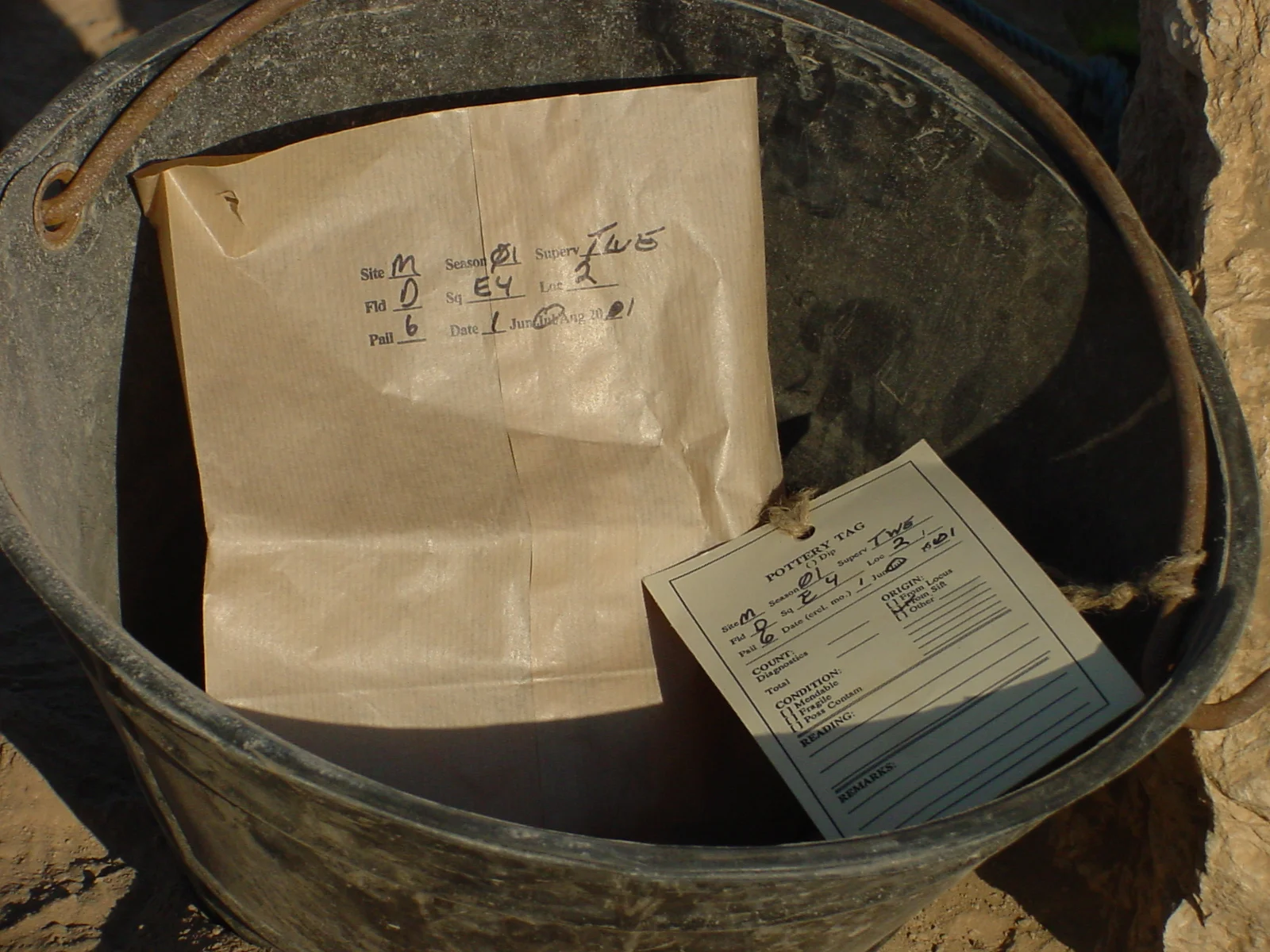
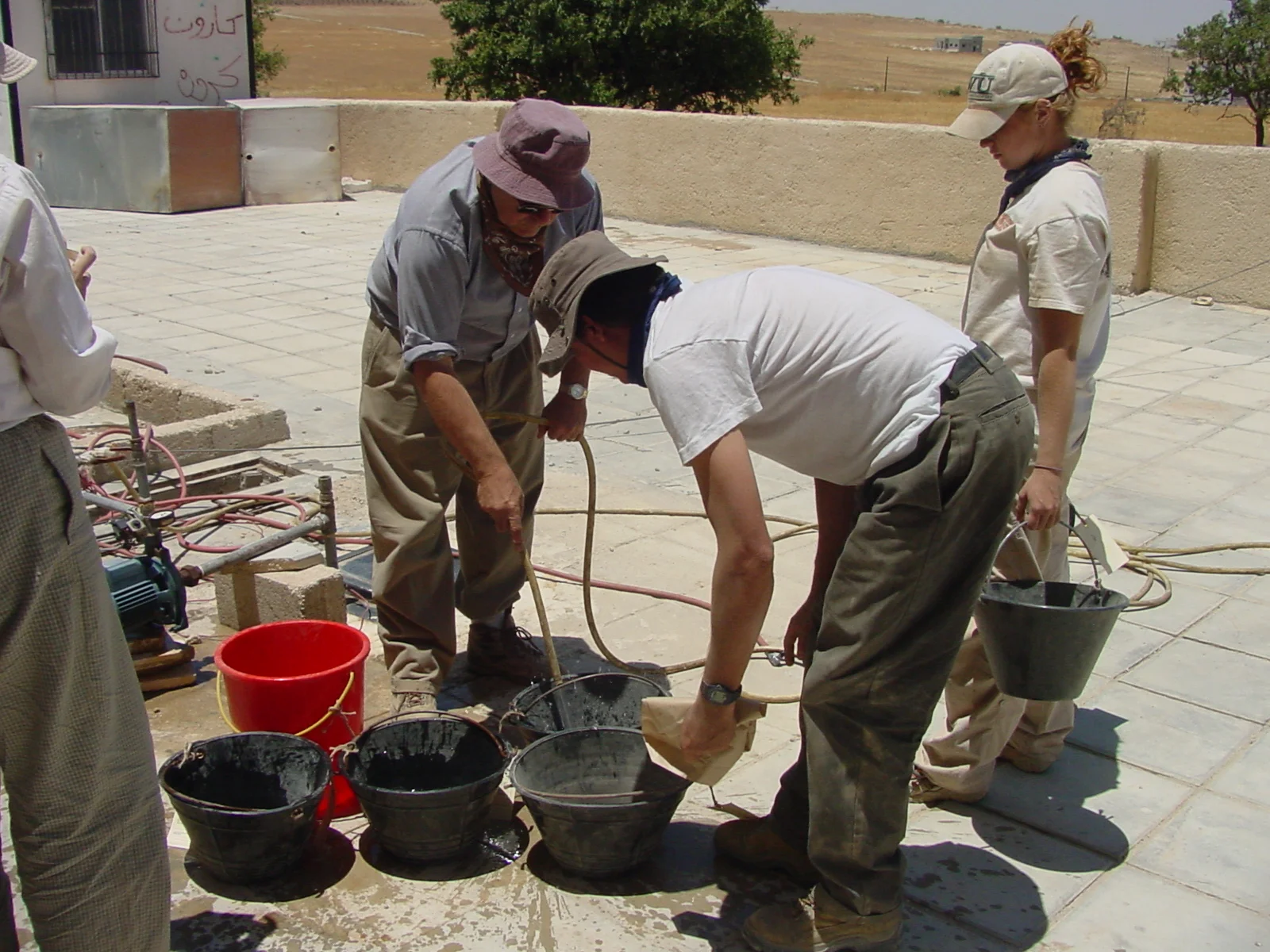
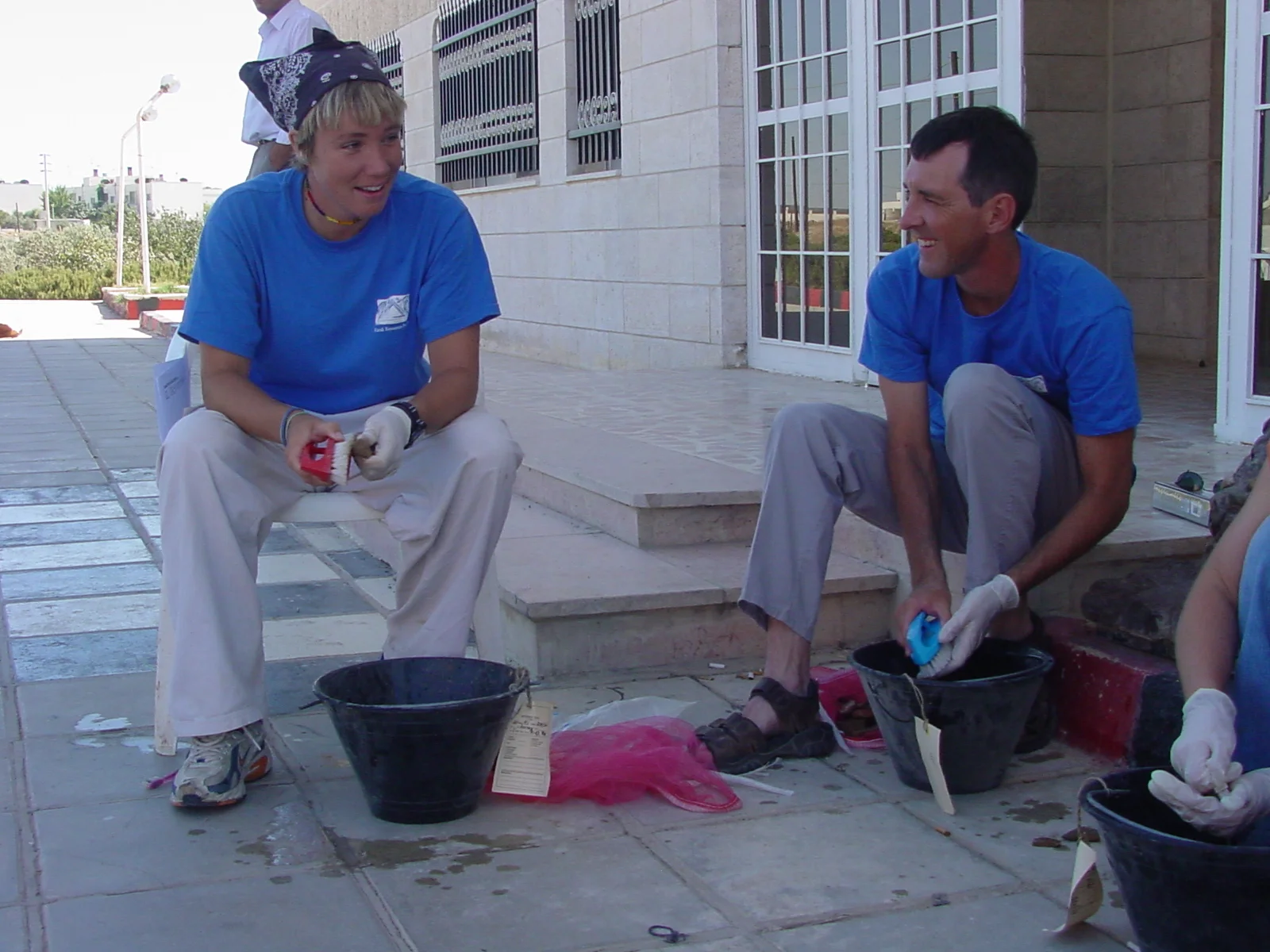
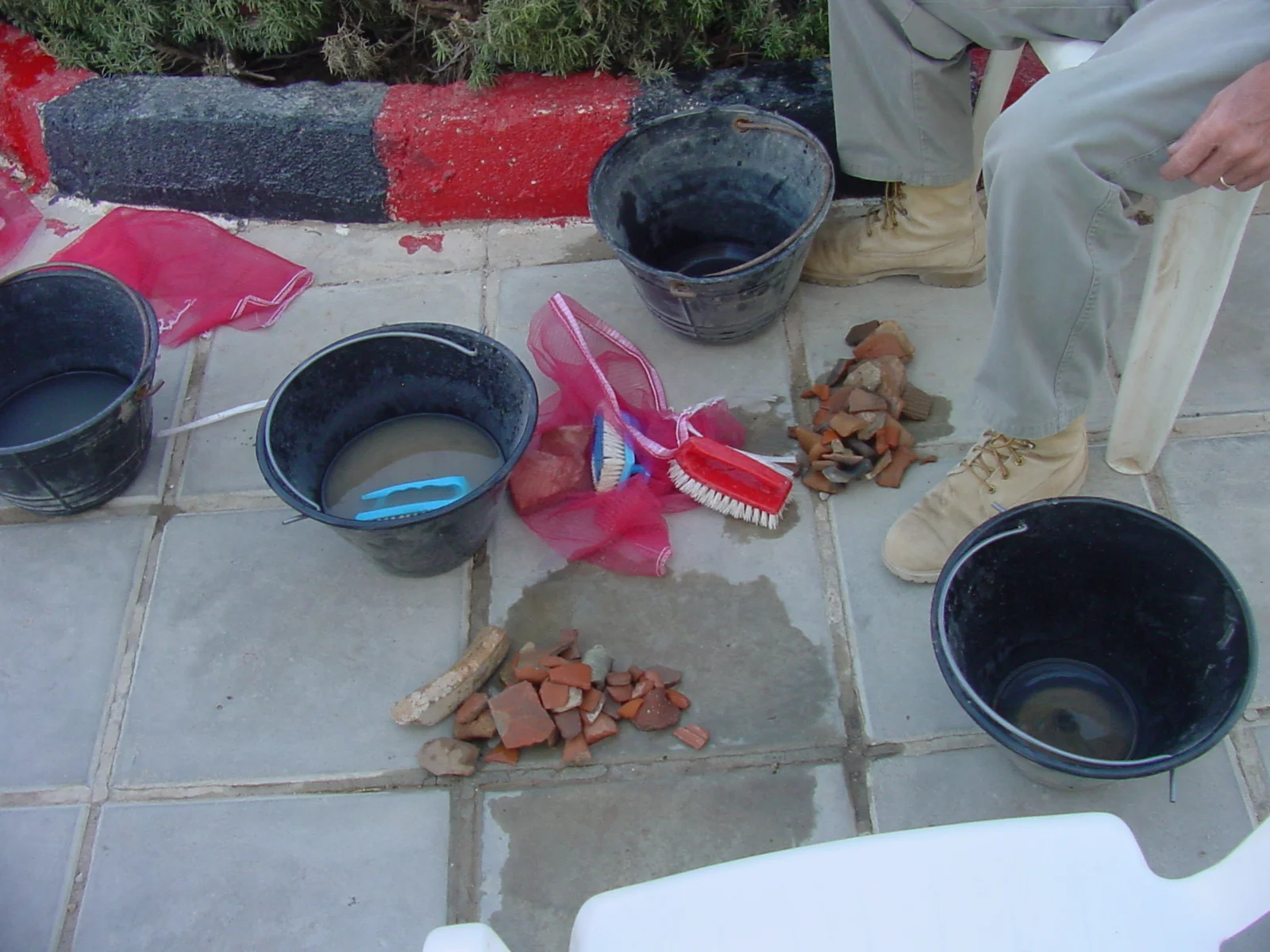
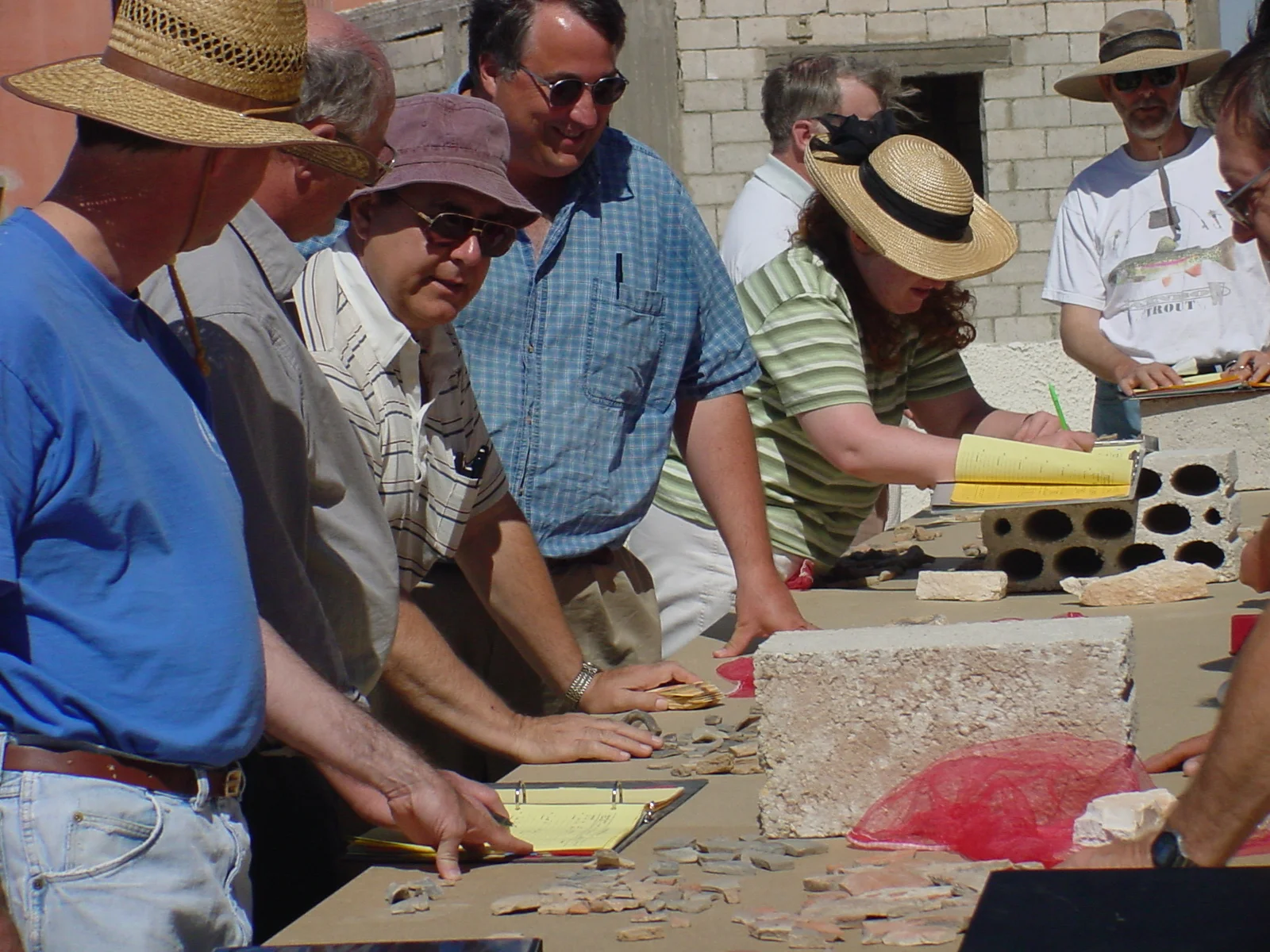



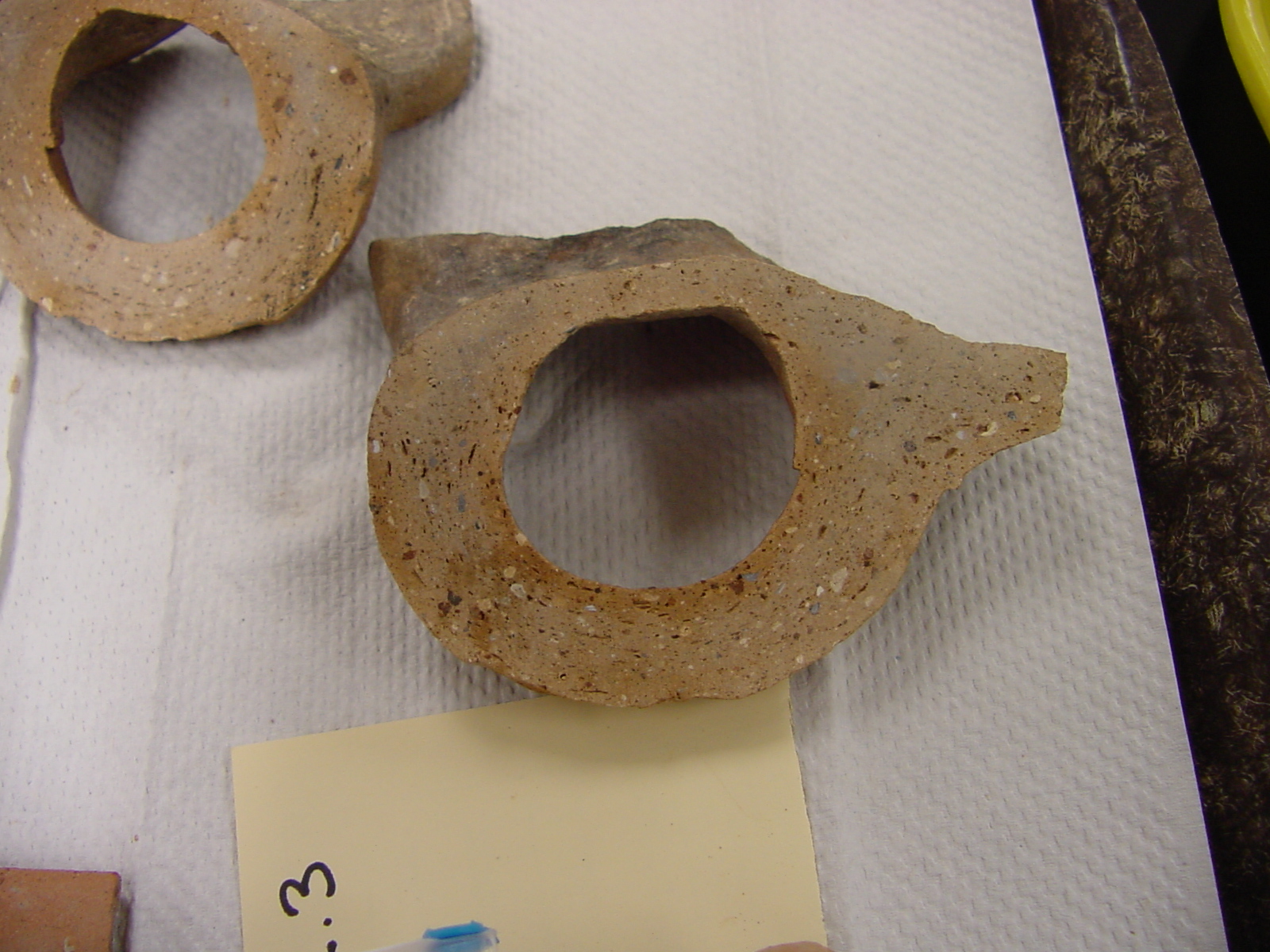
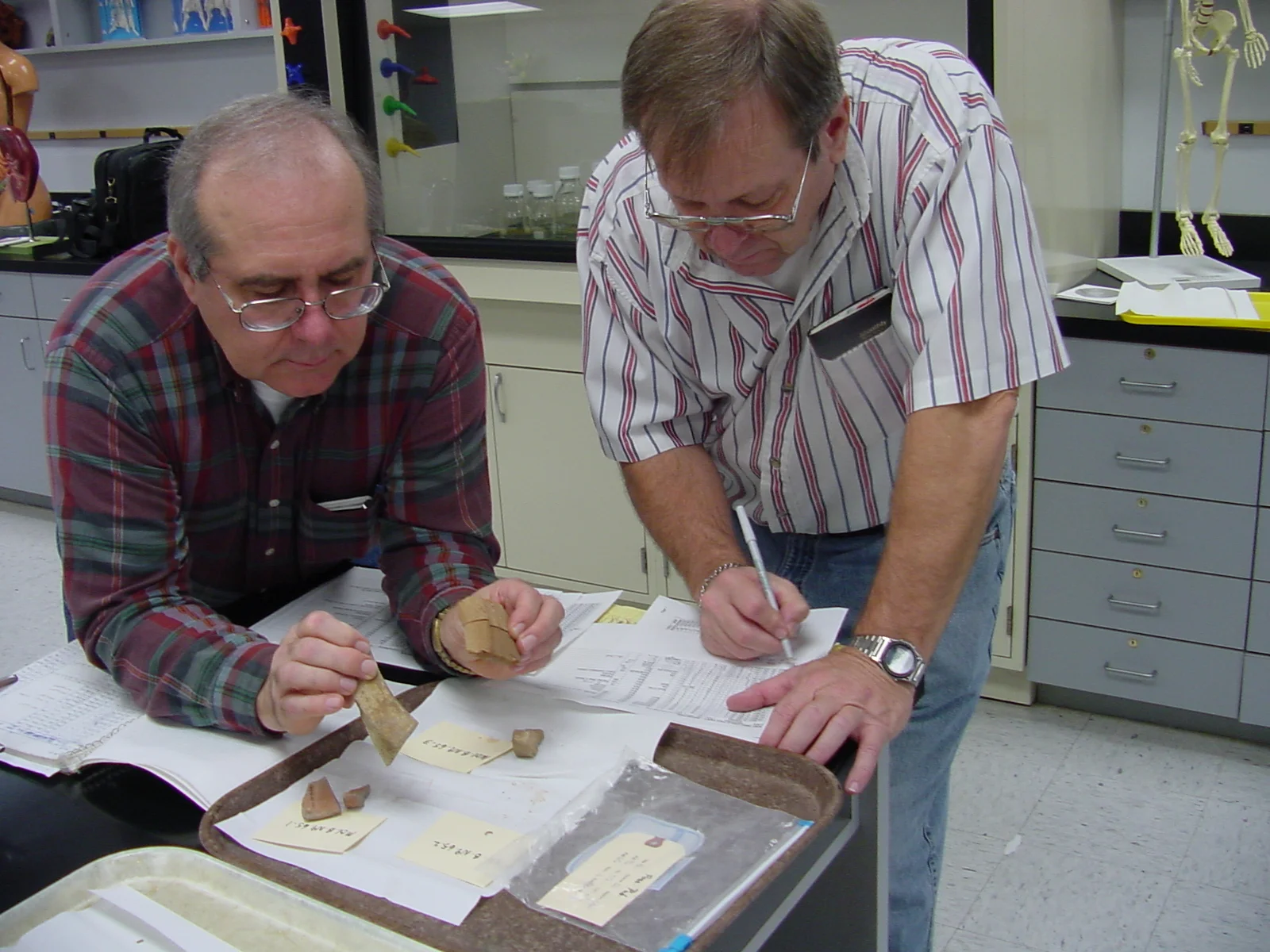
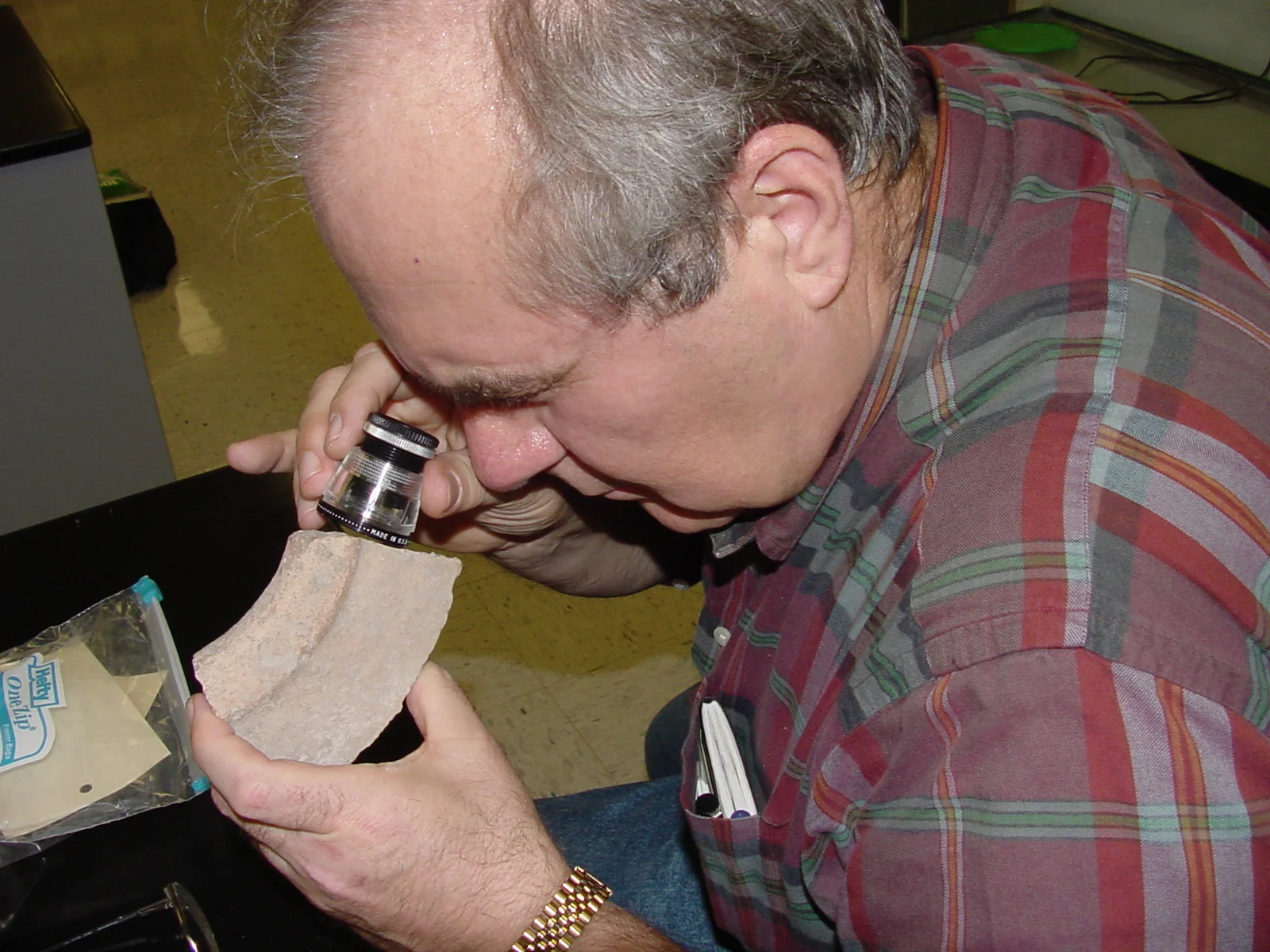


Broken pottery usually denotes that the archeologist has discovered an ancient floor level. The sherd is usually left in place (in situ) when it is discovered in order to make sure that other pieces of the same vessel are not lying nearby. If so, then the sherds are photographed in situ and removed together.

The sherds and soil are then carried to the sift, located a short distance from the square being excavated. The archaeologist who supervises the square keeps a careful record of the location or "locus" in the square where the contents of the guffah originated.

Remaining sherds are removed from the screen and placed in a plastic pail that is tagged with a specific number at the foot of the sift. This pail number is from that point on associated with the sherds placed in it

Remaining sherds are removed from the screen and placed in a plastic pail that is tagged with a specific number at the foot of the sift. This pail number is from that point on associated with the sherds placed in it.

Pottery pail with tag.

The tagged and numbered pails containing the morning's pottery finds are brought back to camp around noon when the workday at the site ends and camp work begins. Upon arrival at camp, workers from the sites squares fill each pail with water to allow the sherds to soak during lunch. At this point it is important to make sure that tags on the pails are sturdy, water-resistant, and labeled with permanent ink. Soaking the sherds loosens the encrusted soil so that they will be easier to wash.Later, in mid-afternoon, everybody participating in the excavation assembles. This is not only a time for practical work, but is also a time to socialize and look over what others have found in their squares at the site during the morning. Using brushes of various sizes, the diggers carefully scrub each sherd. Caution must be taken to examine each sherd carefully before scrubbing. In some cases the ancients used sherds for writing material, known as ostraca (singular, ostracon) to archaeologists. A sherd with any sign of an inscription on it must be removed before washing and taken directly to the head archaeologist, who gives the ostracon special treatment.

Later, in mid-afternoon, everybody participating in the excavation assembles. This is not only a time for practical work, but is also a time to socialize and look over what others have found in their squares at the site during the morning. Using brushes of various sizes, the diggers carefully scrub each sherd. Caution must be taken to examine each sherd carefully before scrubbing. In some cases the ancients used sherds for writing material, known as ostraca (singular, ostracon) to archaeologists. A sherd with any sign of an inscription on it must be removed before washing and taken directly to the head archaeologist, who gives the ostracon special treatment.The washed sherds from each pail are then placed in mesh bags to be left overnight to dry. The mesh bags allow air to circulate and the sherds dry quickly in the arid atmosphere of the Middle East. The tag identifying the pottery is carefully tucked inside each bag so that the archaeologists can always identify the number of the pail in which the sherds were originally placed.

Pottery washed and then dried in mesh bags.

"Reading" is the term given to the initial examination of the pottery, usually by experts with experience in ceramic analysis. It takes place in camp in the afternoon after or during pottery washing. The reading session begins when each square supervisor removes the sherds from the mesh bags after they have dried overnight and places them, along with their appropriate tags, on the reading table. Sherds are counted and the number is recorded. At the same time the square supervisor separates the sherds into two groups. The first group is made up of rims, bases, handles, and pieces with paint or designs on them. These are known as "diagnostic sherds" because the ceramic specialist can detect their dates and uses by comparing them to similar sherds identified from other digs. For example, the experts can tell if the sherd was part of a vessel made in the Bronze Age or Iron Age and whether it functioned as a jar, jug, or bowl. The other group is made up of plain, non-descript sherds called "body sherds." Since little can be learned from them, they are usually placed in tagged bags which go to storage. In some cases they are returned to the site. Of course if there are enough fragments that can be pieced together, they are sent to a specialist who reconstructs as much of the pot as possible. The major attention from this point is on the diagnostic sherds. They are kept separately and are often shipped back to the United States on temporary loan from the host country for study. Special diagnostic sherds that are unusual or will give other archaeologists new information are placed in separate bags labeled "publishable" and sent to the next stage of the pottery process, registration.

During the day, while others are at the site excavating, the pottery registrar stays in camp to record all of the publishable pottery that has been received from the pottery reading session. The registrar assigns a special number to each publishable sherd that will become its identification number and distinguish it from any other sherd found at any other archaeological site in the world. For the Karak Resourses Project excavating Khirbat al-Mudaybicc this number begins with "M" for "Mudaybicc." This is followed by the last two digits of the year of the excavation, the letter representing the field or area of the site in which the sherd was discovered, the number of the pail in which the sherd was placed at the sift, and the sequential number of that particular sherd. A registration number for example is M97A.I3.32.2 - sherd #2 from pail number 32 found in Square I3 in Field A at Mudaybicc in the 1997 season of excavation. The identification number is written permanently on each registered sherd. At KRP the registrar brushes a light coat of clear fingernail polish on an inconspicuous place on the sherd, then applies the number with India ink and, when that is dry, seals the number with another layer of clear fingernail polish.

Sherd information recorded.

Registered pottery must be cut for two reasons: (1) to examine better the interior of the cross section of the sherds and (2) to create a flat surface so that the sherd can be traced when drawn. A saw with a diamond blade is used to make a clean cut across the longest part of the sherd, always preserving the identification number of the sherd.

Pottery rim and handle cut in preparation for drawing.

Cut sherd information is checked against journal entry.

Once the sherd is cut, the color and texture of the fabric used to construct the vessel is clearly revealed. The archaeologist carefully views the fabric with a magnifying instrument called a "comparator." On the lens of the comparator are a series of measured circles and a grid to allow the archaeologist to establish the sizes and shapes of the "voids" and inclusions on the clay. Voids are minute air pockets left in the clay when it was heated or "fired" to make it hard. Inclusions are tiny fragments of ground pottery, straw, or ground stone mixed with the clay so that it would bind better and the heat would spread more evenly through it. Since firing affects the color of the clay, it is also important to record the color of the fabric as accurately as possible in a way that can be reestablished by others who want to study the sherd without having it before them. This is done by comparing the color of the clay fabric to a book of earth-colored chips, much like a painter's sample book, called a Munsell Soil Color Chart. Every shade has its own number, which is recorded by the archaeologists for the fabric inside the cut as well as inside and outside of the vessel itself. Special note is made of any sort of surface treatment. For example, sometimes a clay paint called "slip" was painted on the pot before firing or the pot was rubbed or "burnished" with a stone or shell before it was placed in the furnace or "kiln." It is very important to note circular marks that indicate that the pot was made on a potter's wheel because this may help date the sherd.

The culmination of the whole archaeology process is publication. If artifacts are not made known or are kept in private collections, they are useless, and it would be better for them to remain in the ground. Details of what archaeologists find, where they find it, and how they retrieve it must be made known to the widest possible audience of scholars. This is especially true of pottery. Pottery drawings and ceramic data are vital parts of excavation reports published about archaeological excavations. Ideally these reports appear in specialized scientific journals after each season of fieldwork and in volumes published at the end of the entire project. A glance at any of the literature about archaeology in the Middle East reveals pages of cross-sectional drawings of pottery, accompanied by lists of descriptive data and special observations noting parallels to similar vessels excavated elsewhere in that part of the world. Pottery analysis is always prominent in any discussion of the dating of a site.Recently new scientific techniques have been added to this standard pattern of pottery analysis. For example, extremely thin sections of pottery can be sliced and studied microscopically to determine the kinds of geological materials that make up the clays of the vessels (petrography). With that information geologists can sometimes locate the source of the clays used to manufacture the pottery so that pots produced in certain geographical areas can be identified. Neutron activation analysis provides information about the elements that make up the clay and provides archaeologists another avenue to investigate the origins of pottery. These latest techniques, however, require technical scientific expertise and, at this point, are more expensive than the traditional typological study of pottery most common in Middle Eastern archaeology. New methods of ceramic study assure that pottery will continue to be the most important artifact retrieved in an archaeological excavation in this part of the world.
info
prev / next
1
2
3
4
5
6
7
8
9
10
11
12
13
14
15
16
·
·
·
·
·
·
·
·
·
·
·
·
·
·
·
·